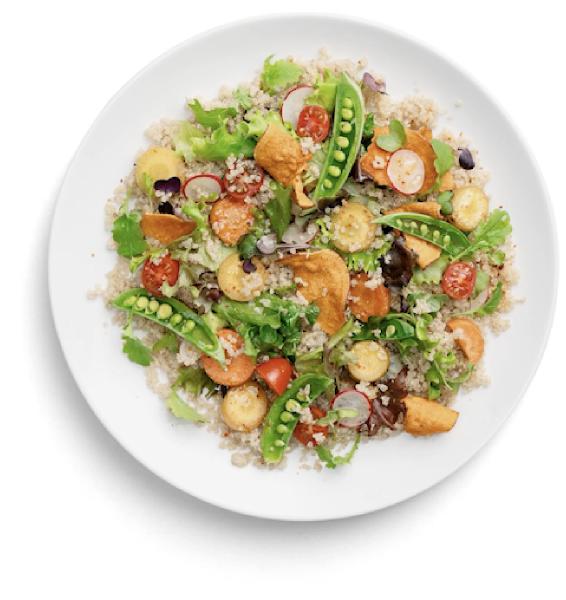Time to cut down on waste
The production and consumption of food generates waste that has an impact on the environment and the economy. Finnish households generate an estimated of food waste per person each year. The by throwing away food is about 500 million euros each year.
We cannot eliminate food waste entirely, but we can reduce it both in food production and at home. The Less Food Waste Project is designed to draw attention to food waste, help estimate the amount of food waste generated by your household, and inspire everyone to reduce waste.
We cannot eliminate food waste entirely, but we can reduce it both in food production and at home. The Less Food Waste Project is designed to draw attention to food waste, help estimate the amount of food waste generated by your household, and inspire everyone to reduce waste.

Try our food waste calculator
With our food waste calculator, you can estimate the food waste generated by your household each year. You also get an idea of the euro value and carbon footprint of your waste, and you can compare the results to Finnish household averages.
QUESTION 1 of 6
How many people live in your household?
1
1
6
QUESTION 2 of 6
Who typically buys groceries in your household?*
Woman
Man
Other gender
We take turns
Prefer not to answer
*Studies show that the gender of the person buying groceries for the household affects how much waste is generated.
QUESTION 3 of 6
How relevant is price to you
when shopping for groceries?
when shopping for groceries?
Not relevant
Slightly relevant
Somewhat relevant
Very relevant
Highly relevant
QUESTION 4 of 6
Does your household recycle?
Always
Often
Sometimes
Never
QUESTION 5 of 6
What is your typical mode of transport when shopping for groceries?
By car
By public transport
By bike
Walking
I buy food online
QUESTION 6 of 6
How often does your household throw away the following food?
In the following questions, food waste refers to edible food and not, for example, banana or orange peels, coffee grounds, or animal bones*.
*Almost daily, Weekly, Monthly, Very rarely, Never / product not consumed in household
Fruits or vegetables
Almost daily
Bread
Almost daily
Cheese
Almost daily
Other dairy products
Almost daily
Fish
Almost daily
Meat
Almost daily
Home-cooked food
Almost daily
Other products
Almost daily
Do you drink coffee?
NO
YES

Your food waste figure is significantly higher than average, so the carbon footprint of waste generated at your home is much bigger than the Finnish household average. Your food waste figure is based on a proportion of the CO2 emissions generated by your waste. The counter is based on the Foodspill study by the Natural Resource Institute Finland with variable analysis applied. Here you can find tips to reduce your waste.
Food waste average in Finland
Amount of food waste
kg
Value in euros
€
Food waste carbon footprint
kg/CO
This equals the emissions of driving a car for
km
You
Finland
You
Finland
You
Finland
CO2
€
kg
Powered by AskKauko
Share your result
Your results
Finishing your plate saves money and environment
In Finland, the estimated is 107 to 137 million kg every year, about 25 kg per person. In terms of money wasted, this means that Finnish households throw away worth of food every year.
Consumption and production of food always has an impact on the environment, contributing over 20% to the total climate impact, or carbon footprint, of all consumption. Only is a heavier burden on the climate than food.
Food production has an impact on, for example, global warming, eutrophication, acidification, and biodiversity loss. In addition, nutrients, land area, energy, and water resources. Of all arable land in the world, is used to produce food that goes to waste. When food is lost, work in primary production goes to waste and emissions generated in the production chain have been for nothing, all the while wasting valuable raw materials.
Consumption and production of food always has an impact on the environment, contributing over 20% to the total climate impact, or carbon footprint, of all consumption. Only is a heavier burden on the climate than food.
Food production has an impact on, for example, global warming, eutrophication, acidification, and biodiversity loss. In addition, nutrients, land area, energy, and water resources. Of all arable land in the world, is used to produce food that goes to waste. When food is lost, work in primary production goes to waste and emissions generated in the production chain have been for nothing, all the while wasting valuable raw materials.
It’s easy to reduce waste
Every Finn throws away an estimated 25 kg of edible food each year. The most common reasons are food going bad and expired dates. Leftovers, making too much food, and reluctance to have the same meal twice also contribute to food waste. Vegetables and dairy products are thrown away more than any other food.
You can easily by taking small steps:
Think about what you actually need and buy accordingly. If you’re not sure if and when you need it, leave it on the shelf.
Read the date labels.
If it’s past ‘best before’, it doesn’t mean it’s bad. You can tell by smelling and tasting.
‘Expiration date’ tells you that the product should be used by that date.
Clean the fridge often to see what expires next.
Freeze your leftovers and be sure to put them to use later.
Prepare for example a delicious leftover tortilla! Check out
Stop perfectly good groceries from going to waste and save money by buying products with
red best before tags or ‘30% off’ labels.
red best before tags or ‘30% off’ labels.
What is Paulig doing
to reduce food waste?
to reduce food waste?
As an international food company and a pioneer in sustainability, reducing food waste is important to Paulig. Paulig’s is based on the UN Sustainable Development Goals. As part of this comprehensive programme, Paulig wants to cut food waste in half across their value chain by 2030.
Food loss and waste is generated throughout the value chain, from growing raw materials to food production and consumption.
A study by Paulig and the University of Helsinki examines the generation of food loss early in Paulig’s supply chain and helps identify ways to reduce food loss in the raw materials production chain. The study helps Paulig better understand which product categories and raw materials have the highest impact and how to reduce food loss in the countries of origin. This commissioned by Paulig also helps other food producers in the future.
Food loss and waste is generated throughout the value chain, from growing raw materials to food production and consumption.
A study by Paulig and the University of Helsinki examines the generation of food loss early in Paulig’s supply chain and helps identify ways to reduce food loss in the raw materials production chain. The study helps Paulig better understand which product categories and raw materials have the highest impact and how to reduce food loss in the countries of origin. This commissioned by Paulig also helps other food producers in the future.
In their operations, Paulig constantly develops innovative ways to reduce food waste:
The Less Food Waste Project
Time to cut down on waste
The Less Food Waste Project draws attention to food waste in every household and inspires to reduce it
Paulig reduces waste as part of their sustainability programme
Your business or organisation is welcome to join the Less Food Waste Project:
Does your business or organisation want to know more about the Less Food Waste Project or join our efforts to reduce food waste?
Get in touch by sending a message, and we’ll get back to you.
Get in touch by sending a message, and we’ll get back to you.
communications@paulig.com
Paulig Group
Satamakaari 20, PO box 15
FI-00981 Helsinki, Finland
Tel +358 9 319 81
Fax +358 9 753 0195
Satamakaari 20, PO box 15
FI-00981 Helsinki, Finland
Tel +358 9 319 81
Fax +358 9 753 0195
We are Paulig
Organisation
Paulig
Santa Maria
Poco Loco
Risenta
Gold&Green
Key figures
Purpose and values
Family-owned company since 1876
Image Bank
Taste the Change
Work with us
Sustainability
PINC
Contact us
Privacy Policy
Privacy Policy for job applicants